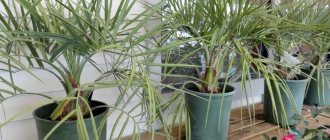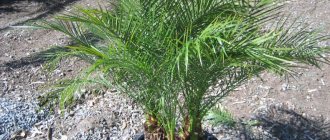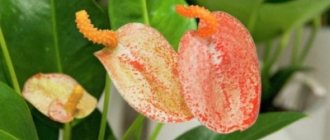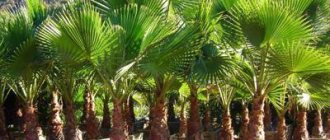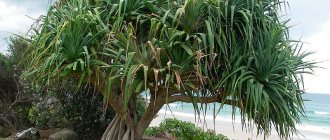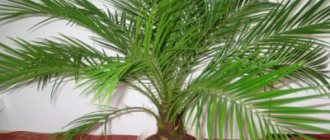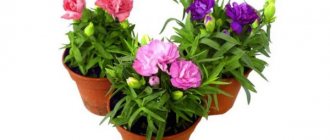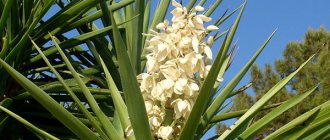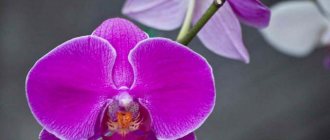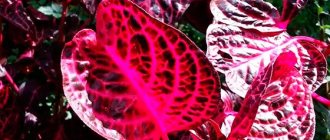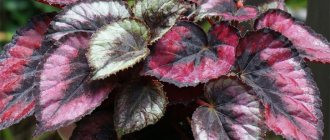The palm family, or palm trees, or arecaceae (Arecaceae, Palmae, Palmaceae) includes approximately 240 genera and 3,400 plant species. The homeland of most palm trees is the tropics and subtropics. Not surprisingly, the ideal environment for most of them is a winter garden. However, many unpretentious palm trees have long been included in indoor floriculture as popular ornamental plants.
- Palm trees in nature and in the interior
- Conditions suitable for growing palm trees Light for palm trees
- Temperature for palm trees
- Water for palm trees
- Replanting palm trees
- Feeding
What types of indoor palm trees are there?
An indoor palm tree is expensive today, so purchasing it remains only a dream for many lovers of ornamental vegetation. Adult specimens of the crop grown in a nursery will decorate any home. However, you should remember that buying a mature plant is very risky. Changing growing conditions is detrimental to the crop and often provokes the development of serious diseases or death of the palm tree.
Therefore, when choosing indoor palm plants in the nursery, give preference to small young shoots that have only a minimal crown of leaves. It is these specimens that more easily adapt to other cultivation conditions and care techniques. Do not be alarmed if there is no green mass on the stem of the crop. It builds up after some time.
We recommend viewing: Lavatera - description, care, planting, photos
The leaves of the palm tree are its most spectacular part. They are characterized by a spectacular shape and appearance that immediately catches the eye. The shape of the foliage is determined by the crop variety. The leaf plates can be straight, narrowed, or even in the form of a semicircle. It is impossible to cut leaf blades from a palm tree, as this may cause the crop to completely die.
Have you not yet decided which type of palm tree to choose for your apartment or house? We bring to your attention varieties of ornamental plants that are in high demand in the floriculture community.
Possible difficulties during cultivation
There are situations when the lower leaves of a palm tree turn yellow and die. If it is one sheet, then you should not be afraid. Problems appear when several plates turn yellow at once, which indicates overflow of the flower or lack of sunlight. These processes will need to be established here.
If brown spots appear on the leaf mass, remove the plant, inspect it, and, if necessary, remove diseased parts of the roots. Treat them with crushed coal and return to the same pot. The disease occurs when there is excessive soil moisture or prolonged drought. If whitish leaves are detected, it is necessary to treat the planting with acaricides against spider mites and thrips.
Palm tree is a beautiful indoor plant that grows very slowly and does not require special conditions. The main thing is to initially choose the right soil, which should include peat, sand, leaf soil and humus. Care follows the standard scheme: moderate watering, periodic fertilizing and protection from pests and diseases.
Bamboo palm - care at home
The bamboo palm is of interest to many gardeners. The original name fully corresponds to the spectacular appearance of the culture. Externally, the leaves of the plant are similar to bamboo. Actually, that’s why this name of indoor palm tree was chosen for this variety of specimens.
Flower growers love the plant because it grows quickly and does not require special care. It just needs to be watered abundantly and regularly. There are 5 varietal types of bamboo palms. Their detailed description is given below.
Planting and transplantation technology
To properly plant a palm tree at home, you must adhere to a certain algorithm of actions. The work should be done carefully, otherwise there is a high risk of injuring the fragile root system of the exotic plant.
Planting/transplanting step by step:
- Prepare a container and soil substrate (2 parts garden soil, 1 part sand and 1 part humus). Before use, the soil mixture must be calcined in an oven or over a water bath. The pot should be disinfected with a solution of potassium permanganate.
- Carefully remove the flower from the old pot and inspect the roots for damage, mold, or rot.
- Suspicious areas should be removed using a sharp and disinfected instrument, and the wound surface should be treated with crushed crushed charcoal; activated charcoal is also suitable.
- Place a drainage cushion made of expanded clay, pebbles, and small crushed stone at the bottom of the container.
- Sprinkle with a thin layer of nutrient soil mixture.
- Place the plant in the center of the flowerpot and fill the voids with soil, gently compacting it.
- Moisten the soil and add more as needed.
When planting and replanting a green pet, it is important not to bury the root collar so as not to destroy it. After such manipulations, it is recommended to place the palm tree in light partial shade for 2-3 days. With this approach, it quickly adapts to the new soil and container.
Finger dates
The palmate date (another name is the date palm) grows in the wild and has a remarkable appearance. It can be successfully cultivated in ordinary apartment conditions. Domestic specimens of the plant are practically no different from their wild counterparts, except for their smaller size. A palm tree of this variety grows up to 2 m at home. To make the crop more compact, trim its top in a timely manner.
We recommend viewing: Venus flytrap
Neanta
Neanta palms are also of interest to lovers of ornamental plants. It is better to buy the crop in a flower shop or nursery when it is still in the small sprout stage. As soon as you move it into the house, immediately transplant the culture into a large container. Next, the main task of the grower becomes to provide a favorable microclimate for the development of Neanta.
A luxurious plant with an extensive foliage crown will decorate your room in a couple of years. Until this moment, the indoor Neanta palm tree requires plenty of moisture and good lighting. If all care conditions are met, the crop will bloom with beautiful yellow flowers at the top, which will later be replaced by berry fruits.
Weddel Coconut
The Weddel coconut palm grows well indoors. True, its appearance will be spectacular and catchy only if the most suitable conditions are created. Palm trees of this variety grow well in the presence of high-quality lighting, optimal temperature conditions, daily watering and suitable humidity conditions.
The decorative palm is an indoor flower that needs to be properly cared for. If all care requirements are met, the exotic culture will delight you with a luxurious appearance.
We recommend viewing: Dracaena: varieties, home care, propagation options
How to water a palm tree at home
Watering requirements for indoor palm trees are determined according to the time of year. Stagnation of liquid in the soil has a bad effect on the condition of the crop. Therefore, it is better to prevent such a problem from occurring. Set up a high-quality drainage system in the flower pot where the palm tree grows. For this purpose, place a layer of large expanded clay or crushed stone on the bottom of the container. In summer and hot weather, water the crop daily and abundantly. In winter, water moderately. Make sure that in winter the soil in the pot is always moist, but not wet.
Temperature
Indoor palms do not cope well with drafts and heat. Therefore, choose the optimal place in your home for cultivating an exotic crop. In summer, in the room where the plant is located, the temperature should not exceed 16 ºC. In winter, it is advisable to maintain the temperature at +10 ºC, preventing the thermometer from dropping below this mark.
Air humidity
In order for palm trees to grow well and fully develop, they must be kept in conditions of high humidity. Place a container filled with water next to the crop. You can do it differently by spraying the leaves of the plant with a spray bottle. In addition, try to periodically wipe the palm foliage with a damp sponge.
Lighting
The palm grows well in a small amount of diffused lighting. It is better to place it in light partial shade and create good protection from the direct rays of the daytime sun.
You can find out more in the Indoor Plants section of the website.”
Top dressing
To ensure that the palm tree grows well and does not get sick, different types of fertilizers are used. Many people prefer store-bought products, but homemade ones have also proven effective. Experts advise alternating fertilizers, using them for root and foliar feeding.
Deadlines
The period of active growth for palm trees begins in April and lasts until September. At this time, the plant needs a large amount of fertilizer. But excessive use of fertilizers can be harmful, so it is recommended to apply them once every 10 days. In winter, plant life processes slow down, so less fertilizer is required. Usually no more than 1 time per month.
When replanting a palm tree, it is not recommended to use fertilizer immediately. The plant must take root in its new location, so fertilizing can only be done after 2-3 weeks. If the palm tree is sick, but the reason is not related to a lack of certain elements, there is no need to use fertilizer. Immediately before flowering, it is more effective to use foliar fertilizing.
Types of fertilizers
Proper feeding of a palm tree involves using different methods of fertilizing. These include:
root;
foliar fertilizers.
A popular method of fertilizing is watering. A small amount of the product is dissolved in water according to the instructions. A palm tree is watered with this mixture:
- pre-moisten the soil with water so as not to burn the root system;
- without using more of the drug than indicated by the manufacturer.
Foliar feeding allows you to additionally feed the plants. The method is simple - the leaves are sprayed with fertilizers. Often, foliar feeding is used in the presence of root injuries, before flowering, or in case of palm disease. The preparation for foliar feeding is diluted in a lower concentration than for irrigation. This is necessary so as not to burn the tender leaves.
Popular means
For indoor plants, purchased universal products are often used. But it is important to choose the right fertilizer that will not harm the palm tree. All fertilizers are stored in a place protected from light and moisture.
Popular quality products include:
| A drug | Compound | Mode of application |
| Complex fertilizer (nitrogen, phosphorus, potassium and minerals) | Dilute 5 ml of the product in 1 liter of water. Used for watering |
| In addition to all the substances necessary for palm trees, it contains seaweed concentrate | For use, dilute 10 ml of product in 1 liter of water. |
| Complex drug. There are several varieties depending on the content of a particular element | 1 g of the product is dissolved in 1 liter of water, then water the plant |
| Universal complex product. Also suitable for foliar feeding. | Dilute 2 g per 1 liter of water |
| In addition to NPK, it contains humic acids, important microelements | For watering use 10 ml per 1.5 l, and for spraying - 5 ml per 1.5 l |
Varieties of Kristalon fertilizer by color:
Green. A universal product, suitable for year-round use.
Yellow. Contains a lot of phosphorus, has a positive effect on plant growth.
Red. Potassium predominates.
Blue. More nitrogen and potassium.
Brown. In addition to NPK it contains sulfur, manganese and potassium.
Orange. This product also contains a lot of potassium.
Nitrogen and phosphorus are washed out of the soil in large quantities, and therefore the plant does not have time to absorb it. Therefore, it is so important to alternate root and foliar feeding (A. Babitsky, specialist in indoor and greenhouse plants).
Homemade fertilizers
The indoor palm tree, like all plants, absorbs natural fertilizers well. They contain a sufficient amount of useful substances. Best suited for fertilizing palm trees:
Banana peel . Banana skins are dried and ground into powder. It is added to water for watering plants or sprinkled on the soil in a pot. This fertilizer effectively saturates the palm with all the necessary elements.
Orange peels . Banana and orange peels are excellent supplements. They are crushed and placed in a three-liter jar, adding 2 tsp. Sahara. Then pour hot water and infuse (from several hours to several weeks). The peel of 1 banana and 1 orange is enough. The resulting infusion is poured over the palm tree.
Potato starch . Potato starch is very useful for palm trees, being a natural source of energy for them. But you don’t need to make starch yourself or buy it in a store. There is a lot of it in the water left after boiling potatoes. Plants can be easily watered with this water. But it is important to ensure that there is no salt in it.
Yeast . If the plant is weakened and needs additional feeding, yeast is used. Use regular or dry yeast. For 1 liter of water, 10 g of yeast and 1 tbsp are required. l. Sahara. The fertilizer is infused for several hours, and before use it is diluted in a ratio of 1:5.
Succinic acid . Succinic acid contains a huge amount of substances useful for indoor plants. Therefore, it is often used as a top dressing. For 1 liter of warm water you will need 1 tablet or 0.20 g of succinic acid. The resulting composition is watered on the palm tree or sprayed on the leaves.
Onion . Onion decoction is used as foliar feeding. You will need 2 liters of water and 50 g of husk. The product is boiled for 10 minutes, after which it is infused for several hours. Be sure to strain before use.
Ash . An excellent remedy that helps quickly restore a plant, improve its immunity and accelerate growth is ash. To prepare the solution you will need 1 liter of water and 1 tbsp. l. ash. The resulting product is watered onto the palm tree.
